Having A Wonderful Time With This!
I’m having a wonderful time with the new Art and Technology podcasts. We recorded our third one this morning. It is about 3D and copyright. A huge topic, and one that I think we will talk about quite often on this podcast. Here is a link to the case that we discussed along with our own experiences and thoughts about digital technology and copyright issues. Last week I had Materialise on the podcast and they shared their process and some of the incredible new things that will be around for artists working in 3D that want to get their artwork out of the computer.
Next week I have another exciting conversation. These are really fire side chats. Informal conversations on different aspects of digital sculpting, and traditional sculpting. The entrance line to the podcast is…
” Welcome to the art and technology podcast at digtialsculpting.net.
A fireside chat where innovation, creativity, technology and science meet.”
Now I just need to get the website up. I’m working diligently at this. It will be a community of artists talking about different subjects.
The Documentation Of Creating a Life-Size Newsboy Sculpture
This part of Bridgette Mongeon’s blog documents the entire process of creating a life-size sculpture from start to finish. You are welcome to follow the links below, of course they will go backwards. But if you want to start from the front and go back, follow this chronological order.
Students and Teachers.
There are study materials, questions and educational material for much of the process. They are listed below.
Archives from sculptor Bridgette Mongeon and
The Texas Press Association Newsboy sculpture
To read previous journal entry click on the desired date
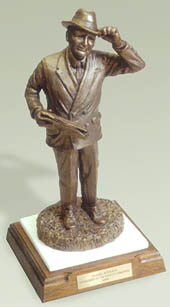
August 26, 2004
The News
I receive the information that I have been awarded the commission of the Newsboy for the Texas Press Association. In this journal entry I share some of passion for sculpting children and the photo of the Jesse Award created for the Houston Chronicle
Students learn about • Art and History
• Geography
August 27-30, 2004
Thoughts on The Project
• The beginning of the thought process concerning the sculpture
Students learn about • The difference between newsboy and news carrier
• The death of a newsboy • The history of newsboys in America and the Spanish American War
August 28
The Beginning
Students learn about • The first newsboy
August 31, 2004
How I Pick a Pose
• An artist’s reference, Picking a pose
Students learn about • The call of the newsboy events that happened in the last 125 years.

Sept 2, 2004
The Meeting
• Meeting with the Texas Press Association • Deciding on a pose
Students learn about • History of the lost wax method

September 5-7, 2004
Beginning the Small Sculpture
• Working with a model and roughing in the small newsboy sculpture
Students learn about • The history of knickers
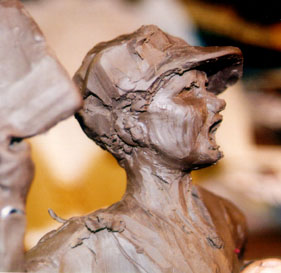
September 8-10, 2004
The Sculpting of the Small Newsboy
• Roughing in the face of the small newsboy
Students learn about • Scaling a sculpture • 3D figures of sculptures

September 11-17, 2004
More Research on Clothes
and Sculpting of the Newsboy
• Researching newsboy outfit, zippers, and suspenders.
Students learn about • The newsboy strike of 1899 • the history of the zipper

September 18-26, 2004
A Sewing Pattern for Knickers
and Sculpting Continues
• Roughing in the small newsboy, finding a vintage 1929 newsboy clothing pattern
Students learn about• How artists use proportion and measurements.
September 27-October 3, 2004-
The Creative Process
• Article Printed in the tribune • International newspaper carrier day
• Creative thinking process
Students learn about • History of the sewing machine
• Sewing a 1929 pattern for the newsboy
October 4-11, 2004-
Sculpting Tricks and More Research
• Sculpting tricks
Students learn about • Motivation with their art

October 11-18, 2004-
Sewing a Vintage Outfit From An Old Pattern
• Sewing the outfit for the model • The final pose
Students learn about • Leisure time of a newsboy • Old toys
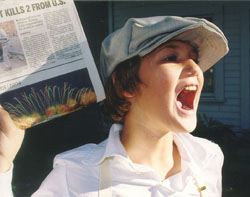
October 19-25, 2004-
The Finished Small Newsboy Sculpture
• Finishing the small sculpture • Receiving approval
Students learn about • The importance of folds and how to create them.
October 25- November 1, 2004-
Preparing the small Sculpture for the Foundry
• Preparing the small newsboy sculpture for the foundry
• A visit to the capitol building
Students learn about • Elizabet Ney and the history of Texas art • The Texas State Capitol building.
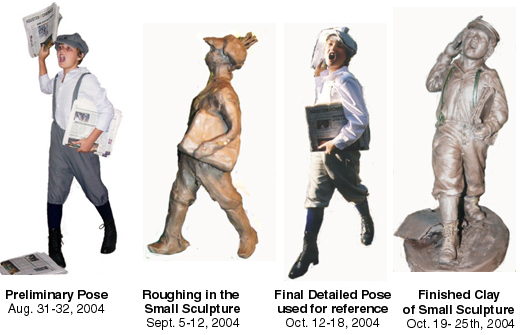
November 2-8, 2004-
Reviewing the Process of Creating
an Original Work of Art
• A review of the previous three months of progress.
• Information about copyrights and limited edition bronzes
Students learn about • Copyrights

November 9-12, 2004-
The Beginning of the Sculpting
on the Life-size Newsboy
• Beginning of the life size newsboy sculpture • Creating the armature
Students learn about • The Penny Press • Yellow Journalism • Newspaper production at the time period of our newsboy
November 13-21, 2004
The Beginning of the Sculpting
on the Life-size Newsboy cont.
• Roughing in the large newsboy sculpture.
Students learn about • How to enlarge a sculpture
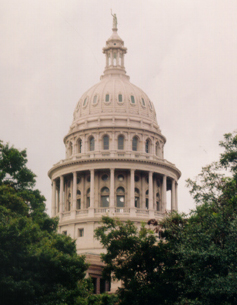
November 29- December 6, 2004 –
The Future Journey of our Newsboy
• The future journey of our newsboy
Students learn about
• The State Preservation Board
• The Texas Capitol building
• Texas Legislature • The Texas Senate

December 7 – December 13, 2004-
Frustration Of the Creative Process
• The future journey of our newsboy
Students learn about
• Newsboy Strike • The zipper

December 14 – December 21, 2004-
The Morphing of a Sculpture
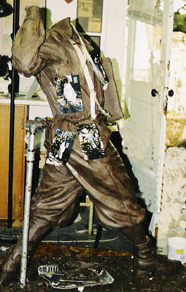
December 22 – December 27, 2004
-Working Through the Holidays

December 28- January 3, 2004-
Huge Strides In the life Size Sculpture
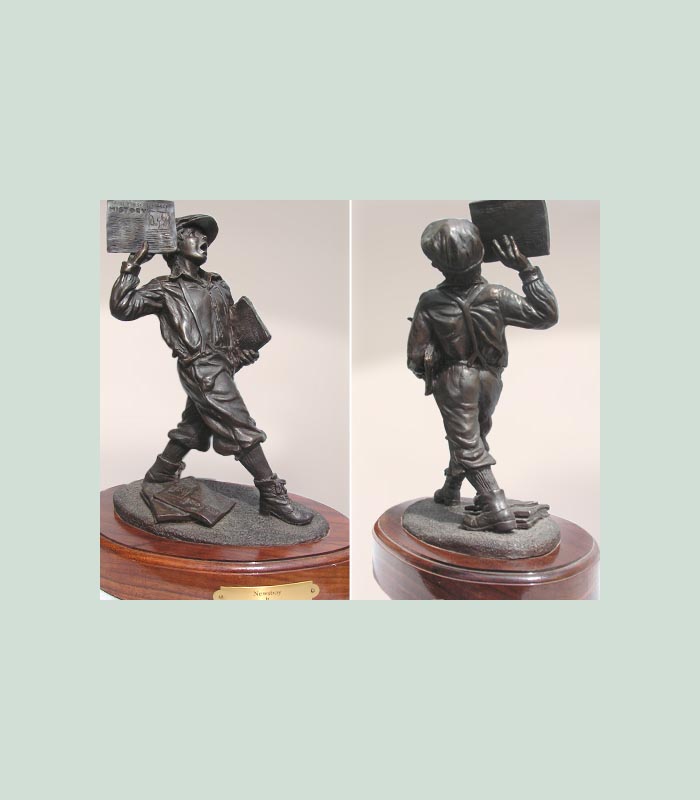
January 3-10, 2005-
Now WeAre Getting There
First small newsboy bronze • Head is added to the life size sculpture

January 11-17, 2005-
Details on Life-Size Sculpture Come Together
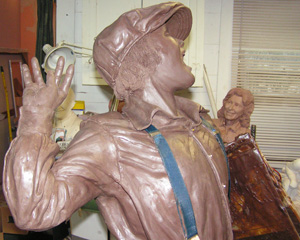
January 18-21, 2005-
Adding the Hand to the Life-size Sculpture and
Sculpting a Newspaper
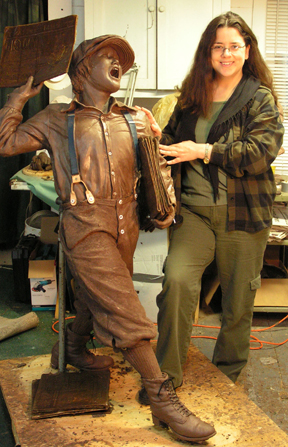
January 22-29, 2005-
Sculpting is Complete on the Life-size Newsboy
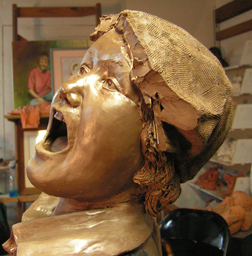
January 31-February 7, 2005-
The Mold Making Process
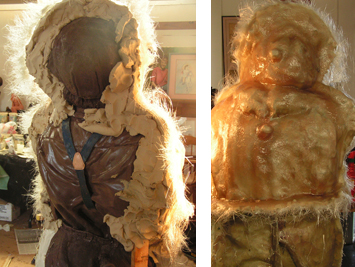
February 8-14, 2005
Mold Making Rubber and Fiberglass
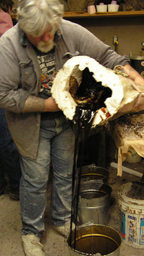
February 15-21, 2005-
Pouring the Wax
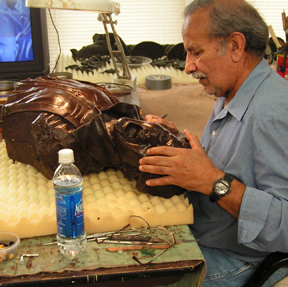
February 22-28, 2005-
Working the Wax

March 1-7, 2005-
The Dip. Learn about the next step in the bronze casting process – the dip.
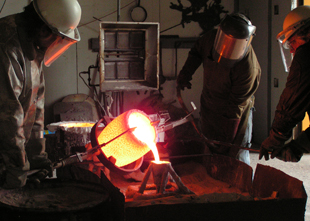
March 8-15,2005-
The Metal Pour
Students learn about • The Bronze Casting Process
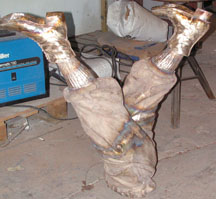
March 16-April 11, 2005-
Putting the Metal Together
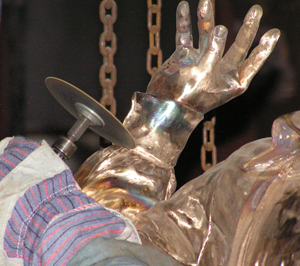
April 12-May, 2005-
Correcting the Metal
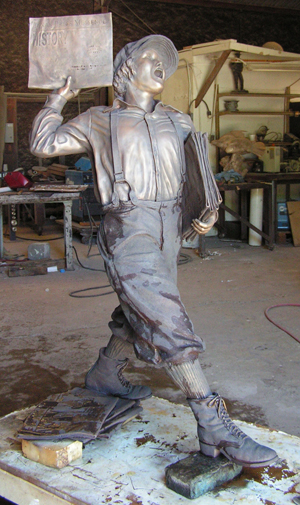
May 2005-
Completion of the Newsboy Sculpture
The newsboy sculpture is complete.
May 8 2005
Newsboy Life Size Editions.
Learn about the editions of the newsboy number one and two.
November 29, 2006
The Newsboy Placed
Bridgette visits Austin Texas and sees her sculpture installed. It is her first time seeing it.
November 28, 2006
Another Life-Size Newsboy To Be Created
For $20,000 the artist sells reproductions of the newsboy. Another paper has purchased a newspaper. They are going to pay the extra $2,000 to have the newsboy headline changed to something of their liking.
December 7, 2006
Another Order For a Small Newsboy
For $1,350 plus shipping Bridgette sends the small newsboys to newspapers all over the country. It makes a great gift for a recognition of accomplishment.
January 12, 2007
A New Life Size Newsboy
See number two in the edition of the bronze newsboy at the foundry in bronze.
May 2005- Present-
The Life Size Limited Edition
The placement of the first in the edition of ten life-size bronze Newsboys and the remaining sculptures as purchased complete with their headlines changed to reflect times in history.
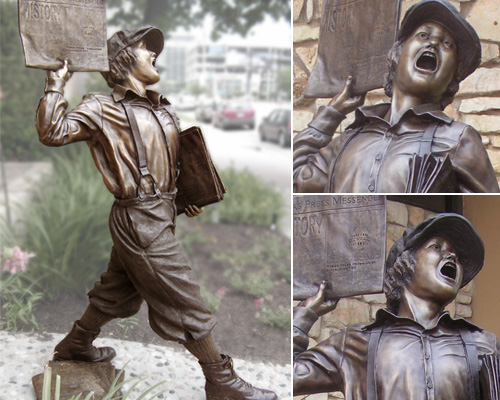
March 23, 2007
Artist Carves History In Bronze
A press release about how sculptor Bridgette Mongeon has a limited edition bronze sculpture in which she creates headlines in her bronze newspaper that match her clients inspiration.

May 21, 2007
An Update on Number Two in the Edition of The Life Size Newsboy Bronze
The artist is honored that the headline for number two in the edition for this paper winning the Pulitzer for their fight against the KKK.
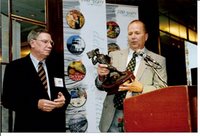
November 27, 2007
Newsboy Goes to Canada
Often people will purchase the small newsboy figurine for awards. Learn about the story of the O’Brien family and their contribution to the industry in this post.
May 19, 2009
It Is Getting Moldy Around Here- LOL
Sculptor Bridgette Mongeon searches for all of the molds of the newsboy to send to the foundry.
May 22, 2009
Body Parts About The Studio
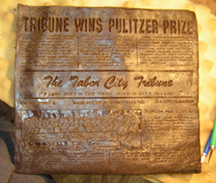
June 12, 2009
Wax Newspapers
Bridgette changes the paper that the newsboy holds to reflect a paper in the history of each collector.
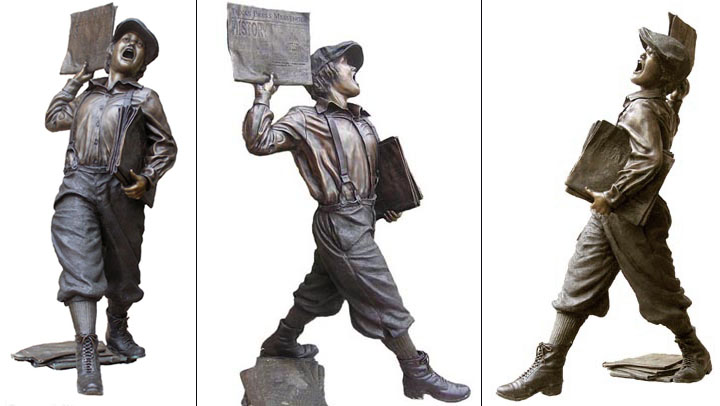
July 10, 2009
Newsboy Commemorates Journalism … Again!
Number three in the edition is sold. This time the newsboy will sell his papers in the North West.
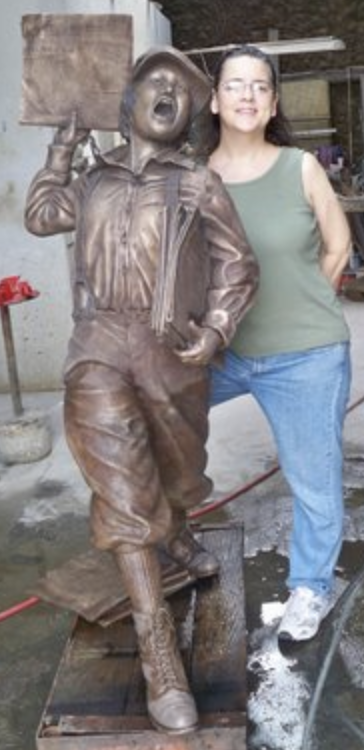
July 21, 2009
The Newsboy Will Ship in The Morning!
The sculpture for the Tri-City Herald ships to Kennewick, Washington. Of course the artist changed the paper.

July 17, 2009
What is a Metal Check?
Sculptor Bridgette Mongeon travels to the foundry. She repeats what she has done so many times before.
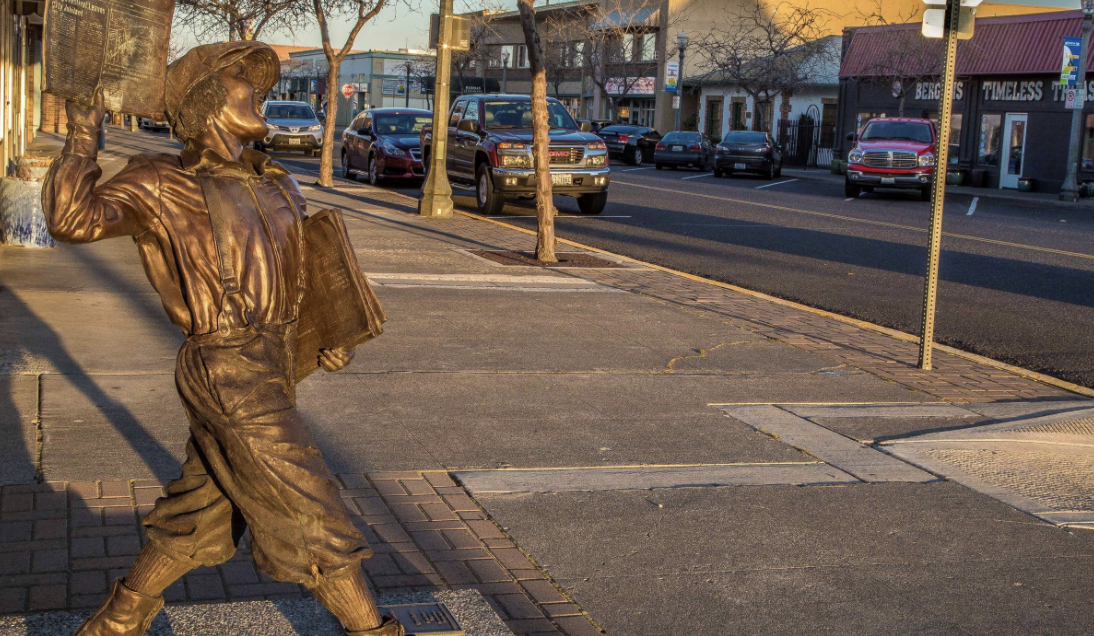
Sept 5, 2009
Recent Media on The Newsboy Sculpture
A Third Newsboy is Placed in Kennewick WA
September 5, 2009
Television Coverage of the Unveiling of the Newsboy Sculpture
Unfortunately the link was removed as of May 2020.
The Newsboy Will Ship in The Morning!
Today was the day that we put color on the life-size newsboy sculpture that is headed to Kennewick, Washington. As I mentioned, the shipping company is picking it up in the morning.
The color on a bronze is referred to as the Patina. This sculpture has a traditional patina.
The client asked to see all of the papers that we created representing the Tri City Herald. There are some under the newsboys arm, one in his right hand and a stack at his feet. All have the headline and masthead of the client’s newspaper.
Upon arriving the sculpture has been sand blasted. It looks less shiny than it did when we were here just last week. The sculpture, once sand blasted is ready to receive the patina.

To create the patina the foundry man first heats up the sculpture and then sprays and brushed on different chemicals. He will rub back areas that are supposed to be lighter. I like to alternate color, shoes dark, socks light, pants dark, shirt light etc. Though once placed outdoors the traditional patina will continue to darken. The foundry puts a protective coat of lacquer on the sculpture one the entire patina is complete.
I’m including some close ups of the detail in the shoe. Yes, it is a sculpted shoe. And my signature and copyright on the piece is in the inside of the newspaper that the young man is holding under his arm. Of course there are other things in the newspapers that carry a story, but that is for another post.

Tomorrow the sculpture is crated and shipped. I can’t wait to see the newsboy placed.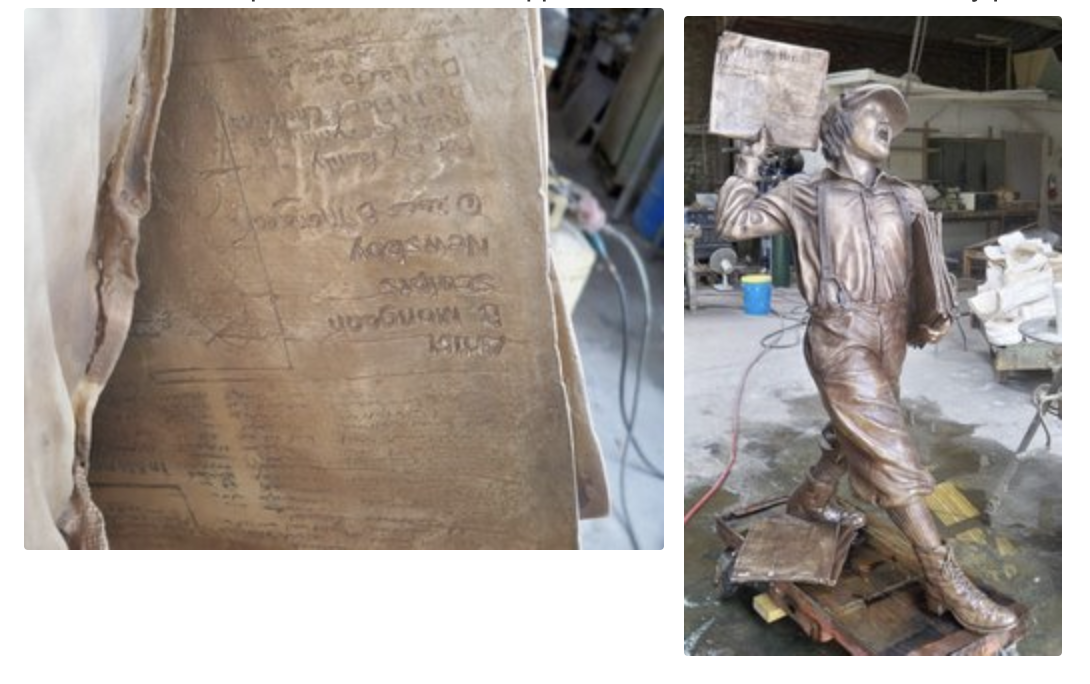
From the Book Shelf of Sculptor Bridgette Mongeon
Created for Best of Artists and Artisans Website.
By Bridgette Mongeon © 2009
When apprentices enter the studio it’s not long before they gravitate to my bookshelves searching for resources on further education, or books that will inspire. I am quick to pull a couple of favorite sculpture books from my bookshelf and comment, “You must look at this book,” or “Every sculptor should have this on their shelf.” Though I never have enough art books and am always open to reviewing new books, I thought I would take some time to share with you a few of my favorites, those that I share with my students and apprentices.
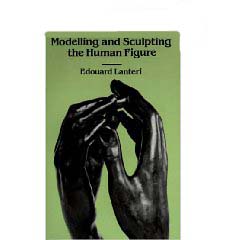
Modeling and Sculpting the Human Figure by Edouard Lanteri
Amazon $10.17
It is my opinion that no sculpture studio should be without Modeling and Sculpting the Human Figure by Edouard Lanteri. The author, Edouard Lanteri was a British sculptor 1848-1917. “The book is a gold mine of technical information, the kind of reference work that should be a lifelong studio companion to the figure sculptor,” as described in the introduction by sculptor, Nathon Cabot Hale. The first of the Lanteri volumes was printed in 1911, my copy is a reprint with a copyright notice of 1965.
Using this book as a study guide will offer the sculpting student a wealth of information that would only be attained in many years of study. Modeling and Sculpting the Human Figure covers portrait busts, full figures, measurements, building of armatures, scales and proportions, poses, and much more. I have especially appreciated the section on draping cloth. We all know that muslin, velvet and silk look different, but how does a sculptor portray the material in clay? No beginning sculpting student or established studio should be without this book.
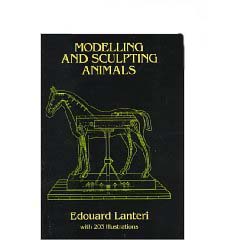
Modeling and Sculpting Animals by Eduard Lanteri
Amazon $11.65
Accompanying Lanteri’s book on Modeling and Sculpting the Human Figure is another book that was an original part of the 1911 edition—Modeling and Sculpting Animals. This book, with a forward written by friend and fellow sculptor Augusta Rodin covers what is in the Modeling and Sculpting the Human figure but in association with animals. Comparative measurements, construction, anatomy, armatures, and much more are featured with a bull, lion and horse as the subjects. Modeling and Sculpting the Human Animals is another book that should be on every sculptor’s shelf.
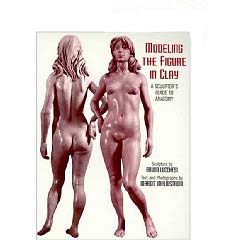
Modeling the figure in Clay by Brunno Luchessi
Amazon $14.93
For another self-taught study on the human form, a book that can’t be beat is Bruno Lucchesi’s Modeling the figure in Clay. In this book master sculptor Bruno Luchessi takes the artist through the entire process of creating a human form from skeleton to skin. Building the sculpture on a wire armature with bones, and then adding on the muscles and skin. I have often thought that this type of book and training would be of considerable importance to massage therapists as well. What better way to learn the anatomy and muscles of a client then to create the form from inside out in clay. A student wanting to hone their skills in artist anatomy would find this book a valuable resource.

From Clay to Bronze by Tuck Langland
Amazon $21.45
For those sculptors who are working toward casting their artwork in bronze, and who may want to understand the process of bronze casting, Tuck Langland’s book From Clay to Bronze is another essential reference book for every sculptor’s bookshelf. Tuck takes us through every portion of bronze casting and even includes a section on the history of bronze casting. The idea that bronze casting has changed so little over such a long period of time, never ceases to amaze me.
Though Tuck does designate some chapters to such things as materials, armatures and modeling, most of the book focuses on the process of reproduction. In-depth segments on making molds, casting, and even using other materials besides bronze for casting your artwork are covered. Then Tuck takes the reader through the entire bronze process of waxes, investment, burning out, chasing, and even patinas and mounting. I especially appreciate the color pages on the process of creating patinas. Coloring a bronze using chemicals is called patination and is a true art in itself. With a copyright of 1999 you know that the resources that Tuck lists are problaby still available and his suggestions of further reading are a way to continue your sculpture library.
For the small investment of $60.00 from Amazon (this could be less if you are buying used books), and the commitment of time and study of these materials, a beginning sculptor could, upon completion know that their study was at the same level as working under a master in a four year university. The only thing missing is the feedback from the master.
Abstinence is a Good Thing
Christina Sizemore is a real life example of how abstinence can work and how it is a good thing. At the age of 14 through the prompting of her church, her youth group, her family, and a commitment through Teen Mania, Christina made a commitment to herself and to God to abstain from sex until marriage. She was able to keep this commitment through junior high, high school, college, and even through a marriage engagement that was called off.
Christina is now married to a wonderful man, who honored that commitment with her. She shares her testimony, “There are guys that have that same commitment, but just because you have that same commitment doesn’t mean it is easy.” She admits that being in a relationship with someone that has that same commitment helps, because it makes it easier in times when you are weak.
“There are times when it is not easy,” and just saying, “I won’t put myself in that position,” doesn’t always work. Christina suggests that having this commitment in your heart, prayer, and other things besides just ‘not putting yourself into the place’ is what she has used to help her through the abstinence years. She assures all, “Waiting is worth it.”
Abstinence can become a commitment even if you have had sex. One of Chris’ friend’s husbands told his wife, “Had I known you were going to be my wife, I would have waited for you.” The gift of sex is a wonderful gift to give your husband or wife. The idea that your future husband or wife is very special, sharing this specialness by waiting can help you when you are trying to abstain.
It is easy to say, “But we are getting married,” and try to justify premarital sex, but Christina explains her situation. “I was engaged to another man, I had a dress, I had a venue, we were going through marriage counseling when I called off the wedding. That happens to real people. I didn’t sleep with him and I am glad I didn’t because he was not my husband. It doesn’t matter if you are engaged or planning on getting married,” Chris states, “You are not married until you are married. My virginity is something that I am giving up to someone who does not deserve it, if they are not my husband.”
Christina’s mom, Bridgette Mongeon encouraged and expected the commitment from Christina. When she would tell others what her daughter was trying to do many, many people thought the idea was ludicrous. One person said that they believed they their son you should “try on the shoe.” “I was livid,” states Bridgette. “My daughter is not a shoe. She is an incredible, precious woman. It bothered me even more that this was a woman who was the mother of a boy my daughter was dating. What values had she instilled in her son?”
Boundaries can’t be pushed. Each time you let down one boundary you get closer to what you don’t want to do. And Chris says there were people she was accountable to, and people who were praying for them as a couple. “I’m not sure they were praying ‘don’t let them have sex,’ but I know people were praying for us.” Bridgette assures her daughter, “Yes, we were praying don’t let them have sex, sometimes when I knew you were alone, I would pray that you would feel uncomfortable, or I would pray one would be strong when the other was weak.” She also let her daughter’s betrothed know what her expectations were of him. “There was no mincing words, they knew what I expected of her, they were sure to know that I understood her commitment and that if the betrothed respected their relationship, and a future relationship, he would respect that commitment as well.”
As a couple there were times when one person would have to be strong when the other was tempted or weak. “That is why it is important to have someone who has made that same commitment,” states Christina. When you have someone who is just waiting because you are waiting, they figure maybe you have changed your mind, and then they don’t help you through your weakness.” Helping with your partners abstinence is a loving and honoring thing to do for one another, it demonstrates character. She does state, “There is an end to the wait. If you wait until after you are married, you can have all of the sex you want. It is worth the wait.”
But people don’t believe that she had not had sex. It is not a common thing and she had to try to convince some people who have asked.
Bridgette states, “We are numb to it, premarital sex is expected and it is accepted.” But she suggests that parents change their minds, gain some courage, and tell their children, “I expect you not to have sex.” Give them something to live up to. Be open about the topic of sex, let them talk about it and encourage open communication, but let them know what you expect of them.
Christina agrees that having parents that are open to talk about sex is imperative. “Don’t let it be an uncomfortable experience. Talk about the biology, your own experiences, and it is important for kids to know it is important to talk about it.” She also assures us that 14 was not too young to discuss such things. Some kids are having sex as young as in the 6th grade.
It is our biological nature to want to reproduce. It is almost unnatural for us to not have sex, and kids need to know that. But Bridgette suggests that dating couples should also discuss their feelings that go with abstinence. A man may feel like he is less of a man, if he does not pursue sex, a women may wake up one morning and feel like she is less desirable. There is a psychological assurance that must go along with abstinence. Communication will help to make it easier.
What if you are having sex in a relationship and decide that is not how you want the relationship to continue? Christina suggests accountability and if your partner is not willing to hear what your heart’s desire is for abstinence, perhaps you should think twice about staying with that person. They might just not be the one for you. The commitment has to be between the two of you with God. An individual commitment as well as one made together. Abstinence is not easy, but it is also not impossible, and it can make a relationship stronger. In Chris’ opinion, “It is so worth it.”
This is an excerpt of the Inspirations/Generations Podcast
“Abstinence A real Life Story A Good Thing” found at http://www.godsword.net/podcastbios.aspx More resources and information can be found on the podcast. Those wishing to insert the podcast link on their website for others to listen to can use this link- http://media.libsyn.com/media/creativeendeavors/INSPIRATIONS_0032_Generations-_Abstinence-_A_Real_Life_Story-_A_Good_Thing.mp3
Copyright 2009
Mongeon is a writer, sculptor, and speaker https://creativesculpture.com
Mother’s Day- Aint She Sweet?
It was the day before Mother’s Day, 24 years ago when the little sweet child was handed to me. Throughout her life my daughter always had a hard time getting out of the house on time, and that first day was no exception. Fourteen hours of labor, and four hours of pushing, I thought it would never happen. It was my wedding anniversary when I went into labor. I delivered her at 5:00 a.m. on Saturday morning. The next day was Mother’s Day!
I remember that first feeding, it felt so blissful, until…horrors upon horrorsI fell asleep. When I awoke, I remembered I had a baby, I remembered I was feeding her, but there was no baby in my arms. Yes, I actually looked over the side of the hospital bed, each side, and then under the covers. I was terrified, how could I be a fit mother if I would let my child fall on the floor the first day. There was no child. I rang the nurse. “MY BABY IS GONE!” I screamed. The nurse entered frantically, ” It is o.k.” The nurse worked hard to calm me down. “She is in the nursery. When we came in to check on you you were fast asleep, no one could wake you, I think that long and difficult delivery finally caught up with you, and so we brought her back to the nursery.”
I was crying.
I thought the nurse must think I was horrible, How would they ever let me leave the hospital with her? I certainly did not feel much better with her reply. I might not have let her fall on the floor crashing and causing irreparable brain damage, but I did let a total stranger take my child from my sleeping arms. What kind of mother was I? I know the nurse meant well but I was humiliated, and I simply blurted out, “I don’t believe you.” I said, “I want to see my baby.”
The nurse was smiling when she came back into my room, how could you not smile when you are carrying such a beautiful child. She put my bundle back into my arms. I should have apologized to the nurse, but I was still mortified and embarrassed by my own behavior and my apparent neglect.
I examined my Mother’s Day gift again. After the nurse left, I whispered to my baby, “I know you are my baby, they did not switch you.” Why I would think they would switch my baby, I do not know. Perhaps I had seen too many movies. “I know you are, not by the bracelet on your wrist, but because of those horrible marks on your head from the forceps delivery.” I stroked the marks, thankful for their identification, afraid, that adding to my chance of dropping my child, and having a stranger take her away I might also add not being able to recognize her to my list of horrors in those first hours of being a mom. “You sure were stubborn.” She sure was a sight with those red marks. But a beautiful sight. This sweet bundle just looked back at me, assured that I was the perfect mom. She trusted me, and she had this incredible ability to make all of my fears fade. At that moment, the room, the hospital, everything, even my husband, everything out of the small circle of her and I, the entire world simply disappeared. It was the strangest experience that I have ever had, I have never had one like it since. Everything simply disappeared but her and I.
Prior to this delivery I prayed at the church alter. I looked up at Father Lon and said, “Would you please pray for my baby?”
“For a healthy baby and a safe delivery,” He stated.
“Yes, that would be nice, but would you also pray that my baby, and my labrador retriever Conan, will get along? He is really a member of the family and I’m a little worried.”
“Hmmm,” Father Lon said, “I think there is a prayer about the lion laying with the lamb, let me see what we can do.”
We called our new baby and first child Christina. The name was picked by Conan, that same labrador. While reading baby names out loud, Conan’s head tipped to the side with intrigue as we read that baby name from a book. This was probably more due to the fact that the dog’s best canine playmate was named Nina, and this name sounded close to Christina, but the name took.
That first day in the hospital I saved her baby blanket that she had been wrapped in, took another from the supplies under her bassinet and sent the “smelly” one home with her father. “Let Conan smell this,” I said. “They say it might help introduce the baby. Tell him she is coming home soon.”
We were alone again. My favorite radio station played big band. I phoned them, ecstatic that it was going to be Mother’s Day, and it was my first day with my baby. “I’d like to request a song please.”
They asked, “What would you like?” I hadn’t thought of what song I wanted, I just said, “Anything that you want, as long as it is dedicated to this sweet thing in my arms.”
Not long after I heard the announcer. “Here is something for a special little baby that came into the world just in time to make her mommy a mother on Mother’s Day.” I listened intently to what they had chosen for my child.
“Aint she sweet, see her coming down the street. Now I ask you very confidentially aint she sweet.” It was the old song “aint she sweet?” by Gene Austin 1927. My toes wiggled under the sheets. I looked at her beautiful eyes, lips and nose, as I sang her song along with the radio, one of the many songs I would sing to her throughout her childhood. “Just cast an eye in her direction, Oh me oh my, aint that perfection? I repeat, don’t you think that is kinda neat, I ask you confidentially aint she sweet?”
I’m happy to report the lion did lay down with the lamb or should I say that the cherished family pet soon learned that his nose was an equal height to the high chair, and this new smelly, squiggly family member loved to throw food over the side of her high chair and giggle when Conan would quickly retrieve it and then, as if on command, he would put his nose back up, barely resting on her tray and look at her longingly. It caused an instant rapport. Yes, there was a period of time when Conan had a regular diet of Cheerios and baby food.
My baby was married this year, and I’m sure her husband agrees with the song that was played on her “birth” day. I can’t help but think it won’t be long before she is having a baby of her own, and Mother’s Day will become something that she no longer celebrates for someone else but is celebrated for her. Until then, I still find her incredibly sweet, and confidentially, she is still my baby girl and perfection.
Copyright 2009
Mongeon is a writer, sculptor, and speaker https://creativesculpture.com
Mother’s Day- Letting Go
Mother’s day might not be a happy day for all women. In fact, there may be some women who are, for whatever reason, estranged from their children or their may be children estranged from their mothers. For these people, watching happy families on Mother’s day can be quite painful. There is no doubt that the pain that is felt through and by these broken relationships or the injustices caused one to another is real. But this Mother’s day, begin to give yourself the gift of letting go. Let go of the pain, the anger, and the resentment, and begin to pray for forgiveness.
This is not an easy task. Withholding anger concerning your expectations of someone turns into resentment. Holding on to resentment makes you feel justified. However, there is documentation stating that resentment and unforgiveness can make you physically sick. It could even shorten your life. Resentment can cause depression, change blood pressure, and heart rate. Resentment releases stress hormones and maintaining that resentment can cause permanent physiological damage. In short, holding on to resentment causes more damage to you than the person you are angry at.
It is difficult to forgive someone who does not admit they are wrong or who has not asked to be forgiven. Pray that God softens your heart, and if you can pray for nothing else pray that God gives you what I call the “want tos.” “Lord help me to ‘want to’ forgive,” and try to remember when you too needed forgiveness.
Often the chance of reconciliation grows dimmer as the distance grows greater. At times it might feel like it is just easier not to try. If you are the person that needs forgiveness approach the one that you have hurt in a humble manor. Pray often to God to forgive you and to heal the relationship as you continue to try to reconcile. Also, forgive yourself. Barbara Ingersoll, known as Gram in our Inspirations/Generations podcast, said it took years for her to forgive herself for what she had done to her children. You must learn to forgive yourself as well.
Forgiveness can still happen after the death of a loved one. Once again pray that God heal the relationship. Nothing is too big for God. He can heal even through death. This will allow you to let go, and in turn it will give space in your heart for other blessings.
Let all bitterness and wrath and anger and clamor and slander be put away from you, with all malice, and be kind to one another, tenderhearted, forgiving one another, as God in Christ forgave you.
Eph 4:31-32
Copyright 2009
Mongeon is a writer, sculptor, and speaker https://creativesculpture.com
Sculpture- A Reflection of Faith
Created for Best of Artists and Artisans Website
By Bridgette Mongeon © 2009
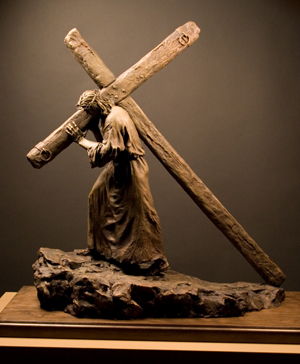
We are in the middle of what some would call a holy season of Lent, leading up to Passover, and then Easter Sunday. This solemn time of reflection in faith caused me to seek sculpture that does the same. In this month’s article we will showcase the work of traditional “liturgical art,” as well as not so traditional art based on the faith or with a message of faith. When reviewing different artists it is important for me to hear the description of the art. A titled work and descriptions add life to the piece, gives it meaning and creates a rapport between viewer, art, and artist. Equally, there is an urgency in my discovery of the process of each individual artist. I want to know more about their own faith. What drives them to spend so many hours creating these images? Is it of necessity that they driven to create? Do they feel a message must be conveyed? Is there a spiritual dance between them and the Great Creator as they mingle passion, art and faith? Here are the answers of five passionate and spiritual artists.
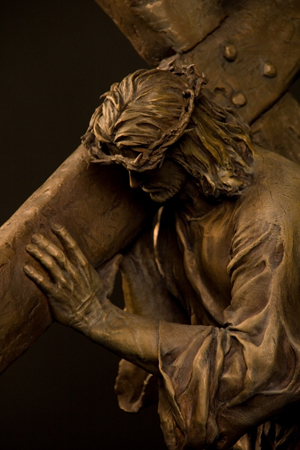
ArtistAngela Johnson
www.ajsculptures.com
Art quietly speaks volumes. At this Easter time it gives me joy to share my pieces, Because of Love and Lazarus, Come Forth. The most fascinating aspect of art for me is what can be communicated from the artist to the viewer. Every artistic decision of compositional design is determined with the desire to share a perspective,
belief or quality about the subject being created. In the sculpture, Because of Love, it was my desire to portray the incomprehensible act of love of Jesus Christ is suffering the weight of the sins of the world. The majesty and power of His love is portrayed and embedded in this work. The strain of His muscles, His bearing being strong, yet submissive to the will of His Father are meant to draw the viewer into contemplation of His Great, Infinite sacrifice of Love.
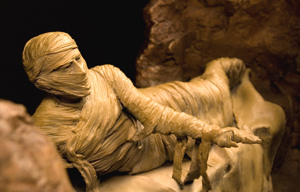
Lazarus, Come Forth sculpturally depicts the miracle of Jesus raising Lazarus from the dead. The biblical account states that Lazarus had been in the grave four days. Beyond all the miracles Jesus Christ had already performed was this yet greater impossibility of raising someone from the dead long after their spirit had left the realm of earth. I think a great deal about the reaction of Mary and Martha as they struggle in amazement and disbelief as they see their brother who was one dead, alive again. When we pray and ask God to grant a blessing or we personally witness a miracle what is our reaction? How grateful and changed are we as we experience the power of God? Do we give God the glory or dismiss it as an unexplainable coincidence?
Artist
William Leslie
www.PaperSunLightsculpture.com
At the heart of existence there shines a light; Ner Tamid, the flame of the Divine’s ever radiant Presence. This light, which emanates from the inside out, expresses the timeless ideals towards which all individuals and nations strive; Wisdom, Love, and Justice.
Wisdom is the knowledge of the true nature of the human condition and the Sacred Mystery; Love is found in the deep concern for the well being of all living things, especially the least advantaged and most vulnerable; and Justice is the manifestation of Wisdom and Love in action, the right ordering of society such that the dignity of all is cherished and protected.
These three virtues are expressed in the three upward aspiring fingers of the flame in this representation of Ner Tamid. Their unity and interdependence is signified by the manner in which the three fingers twist around each other after emerging from a common base.
It is the wish of the artist that this expression of the Eternal Flame inspire every individual and all nations to be exemplary lights to guide humanity through the dark night of these bewildering times, and to remind us of the undying presence of the Divine.

The aesthetic appeal of my lightsculptures is evocative of what we find beautiful in natural forms; the swirl of texture in marble or wood grain, the evolving folds in flowers or lichen, the patterns left in windswept or sea swept sand. Everywhere we look we see that nature prefers to move in graceful trails, or to organize itself in beautiful patterns.
I began thirty years ago calling my work “lanterns” or “artistic light fixtures.” Gradually my work has evolved to become more sculptural, less functional. While my clients (ranging from homes to businesses, hospitals to restaurants) are often seeking a source of illumination for an occupied space, they also desire something that stands alone as a work of art whether the light is on or off. It is this wish to grow beyond the functional, to create truly beautiful illuminated sculptural forms that motivates my efforts now.
Ner Tamid resides in Unitarian Universalist Fellowship in Vista, CA.
ArtistNancy Winship Milliken
www.nancymilliken.com
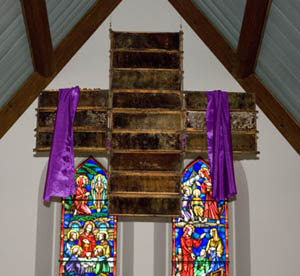
Out of Many, One, dimensions variable upon installation (cross is 51”x51”x2”), wood, beeswax, honey, muslin, steel, 2008.
The piece is constructed out of honey frames from a bee hive. It has the balance of the Red Cross symbol as it hangs suspended from the ceiling. There is a waxed muslin catch-pan filled with honey underneath and waxed muslin is draped over the extended arms of the cross. There is a lovely sweet smell of wax and honey and a depth of natural color of the old honeycomb.
Out of Many, One, II, dimensions variable upon installation (cross is 51”x51”x2”), wood, beeswax, steel, polyester, 2009. The piece is similar to the above Out of Many, One description except without the catch-pan of honey and the material draped is interchangeable, purple for lent, red and black as needed. This cross now installed at Calvary Church in Stonington, Connecticut, will come down for Easter and be replaced with a cross that I have made out of the same frame construction, filled with white flowers.
The Lamb, installation size variable,( 7’, 10’, or 15’) wool, felt, polyester, 2009. The wool has been kept in the raw, so the smell of lanolin and animal is vaguely familiar, ancient, visceral. The wool is needle felted into a felt substrate, using an old technique employed by homesteaders all over the world. The subtle colors and design of the wool, the texture and smell present in contrast to the purple polyester shine adds intrigue and contemplation.
Artist Statement
Art for me is where science and the spiritual connect. For these above mentioned pieces the concepts of sacrifice and service were always front and center. Out of Many, One, is titled for both the collaborative work ethic and social constructs of the honeybee colony and our national motto, E Pluribus Unum, found on the seal of the United States and on our dollar bill. The bees work for the benefit the whole colony, even giving their lives in defense of their productive hive. With the recent colony collapse disorder that the nation’s bees have been experiencing, I believe the materials that I have chosen to be symbolic of not only humanitarian behaviors, but also reflective of our environmental impact on the honeybee.
In choosing the symbol of the cross, and in particular the Red Cross, I am referencing the humanitarian gesture of service to others with disregard to country borders, skin color, sexual orientation, wealth or religion. Anyone who has experienced a natural disaster, a manmade calamity, or even succumbed to the power of water while swimming knows the calming effect of the Red Cross symbol flying on a flag meaning help is near. It is powerful and instills the feeling of hope as well as symbolizing sacrifice and service. The lamb has historically been a symbol of sacrifice. The method of attaching the fiber by pushing the wool into the felt with a long needle is laborious and a nod to the essential work of the homesteader. The contrasting shiny purple material representative of the color for Lent and the practice of doing without highlights the natural and authentic smell and texture of the wool.
As a last note about these pieces: They personally symbolize the faith I have in my art. I made a change in my career two years ago and I need to have faith in the unknown, the unseen, the future. By using untraditional materials unconventionally in my art, I am entering un-chartered territory. These traditional symbols are a reminder, a flag, of faith in my art.
Artist
Robert Winkler
www.robertwinklerscupture.com
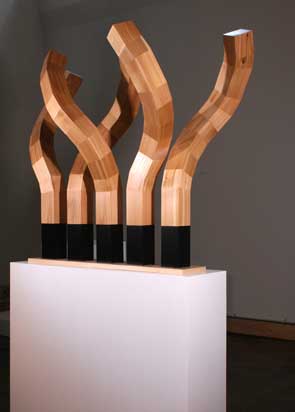
People often ask Robert Winkler what inspired one or another of his sculptures.
But, the more relevant question for Winkler is “what do his abstract forms inspire in the viewer?”—particularly in the case of Look Homeward, Angles. Like all of his works, it is deeply spiritual, humble in its simplicity and lack of ornamentation —with a minimal flow that allows the imagination to soar unimpeded.
In Look Homeward, Angles, his graceful-gravity challenging forms seem to resist the downward pull of the Earth and reach heavenward.
In a recent series of interior sculptures, Grow Up, the prayerful attitudes and upward reach of the twisted forms are both a paean to ephemeral beauty and a moving metaphor for the human struggle to transcend.
Since the early ‘90’s, Robert Winkler has been manipulating volume, mass and balance to create a sense of movement. His interior works make use of surprising combinations of materials, such as aluminum, steel, hand-laid papers, vellum, tempered masonite, and cedar. His large-scale outdoor works are primarily constructed of cedar, an organic material whose surface changes over time. Above all, it is his ability to find infinite variation within a limited number of shapes that sets him apart. Without so much as a single curved cut of wood, he achieves serpentine, animated forms through the use of incremental gradations. It is a discipline that offers no hiding place for error, demanding meticulous workmanship.
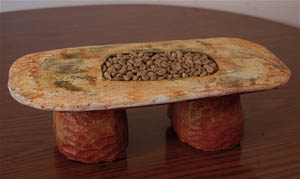
Artist
Sean Matthews
www.flickr.com/photos/seansaltars
My first experience with sculpture dates back to childhood. As a boy, Sunday Mass was the least exciting hour of the week and I often found myself daydreaming. I can think back to a reoccurring daydream of the Church spontaneously bursting into flames during a Sunday morning celebration. While the congregation was frantically storming the doors for safety, I was calmly carrying large marble sculptures of the Holy Family out from the fire. I remember thinking how I would be the hero who saved works of art from a burning church.
From time to time, I still find myself daydreaming during Mass. One Sunday, about six years ago, after my first semester of graduate school, I made a discovery that changed my process of object making. During Mass, while we were solemnly kneeling, I noticed a predominant object for what seemed to be the first time. I looked around the congregation and saw how all eyes were focused on the priest and the ritual he was performing around the altar. I remember looking at the altar as if it were a piece of minimal sculpture anchored in the center of a highly conceptual, performance piece. I was immediately inspired, and my mind began to race with ideas. This was a defining moment for me as an artist.
From the beginning of civilization, in every culture around the world, sacred articles, such as altars, shrines, and sanctuaries have been used to connect us spiritually to a place outside the physical world. I have found the altar to be a unique tool that can take almost any form so long as it has been consecrated to a significant purpose. The spiritual object symbolizes religious or secular memories and acts as a focal point where one prays, contemplates, or meditates.
I see the altar as a vehicle that drives a thought or a prayer into an intangible world. It makes an imperceptible connection between the participant and a memory. It is the tool that connects us to a thought, emotion, or a recollection, making visible that which is invisible. An altar can be specific to a location, or small enough to fit in one’s hand. It can be personal or for others, and is possibly the only devotional object that can connect all people, around the world, from the beginning of time through to the present.
My body of work revolves around the altar and its infinite forms. I explore the similarities between the altar and the object, and ask the viewer to determine the difference between the two. Form and craftsmanship is very important to my concepts because I believe that beauty in art is an extension of God. Mark Rothko writes, “The artist m
ust have sufficient means at his command to achieve his objective so that his work becomes convincingly communicative.”
My latest work is inspired by a Sicilian tradition called St. Joseph Altars. The focus of St Joseph Altars is baked goods and fruit. Breads are baked in symbolic forms such as carpenter tools and tools of the Passion; every food item on the altar has a special meaning. Because this tradition is practiced during Lent, meats are not included on the table. I have appropriated the idea of building an altar to a saint, but instead of paying homage to Saint Joseph, I am communicating my gratitude to Saint Luke, the patron of sculptors. In this body of work, small sculptures replace food. The materials I use are found objects and recycled wood and steel. My purpose for using these materials is to symbolize the Resurrection.
Altar XV
Plastic, cement and coffee beans,
Microlithic Altar
Wood and steal
A Bean Picker’s Altar
Wood, steel, coffee beans, coffee bean bag
All written work is copyrighted and cannot be used, whole or in part,
without the written consent of the author.
Artists Taking Action

Created for Best of Artists and Artisans web site
By Bridgette Mongeon © 2008
Recently I received an e-mail in my inbox that caused me to clean my clay filled hands and take action. It was from sculptor Boaz Vaadia in Brooklyn, NY, expressing urgency in supporting the Artist deduction bill S. 548 and HR 1524. The e-mail included links to Americans for the Arts. This is a wonderful organization that is working for each of us. According to their website:
Americans for the Arts is the nation’s leading nonprofit organization for advancing the arts in America. With 45 years of service, we are dedicated to representing and serving local communities and creating opportunities for every American to participate in and appreciate all forms of the arts.
This bill S. 548 and HR 1524 is described on the Americans for the Arts policy and advocacy page, but let me sum it up in this article.
Since 1969 those working in the arts have not been allowed to deduct the fair market value of their artwork when donating it. The bill “would allow creators of original works to deduct the fair-market value of self-created works given to and retained by a nonprofit institution.” Currently, those working in the arts can only deduct what it cost to create it. Here is some more information from the Americans for the Arts website that indicates the importance of this bill and how immediate the effect of the 1969 legislation was.
- The Museum of Modern Art in New York received 321 gifts from artists in the three years prior to 1969; in the three years after 1969 the museum received 28 works of art from artists—a decrease of more than 90 percent.
- The biggest loser was the Library of Congress, which annually received 15 to 20 large gifts of manuscripts from authors. In the four years after 1969, it received one gift.
- Dr. James Billington, Librarian of Congress, says, “The restoration of this tax deduction would vastly benefit our manuscript and music holdings, and remove the single major impediment to developing the Library’s graphic art holdings. [The] bill would also benefit local public and research libraries. When this tax deduction was allowed in the past, many urban and rural libraries profited from the donation of manuscripts and other memorabilia from authors and composers who wanted their creative output to be available for research in their local communities.”
H.R. 1524 and S. 548 are identical to legislation that the Senate has passed five times in the past few years, but that has not been reviewed by the House.
This bill affects every creative person, not just sculptors. Please take note.

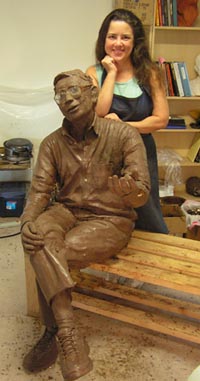
Since I learn best by example, here is one for you to ponder. I have created a life-size newsboy sculpture. There are 10 in the edition of the life size sculpture and they sell for $23,000. I have sold two in the edition. One for the Texas Press Association, who commissioned me to create the piece, the second for the Tabor City Tribune. It costs me approximately $6,000 to pour the newsboy in bronze. I have worked hard to develop a reputation as an artist and to sell the remaining in the edition spending hours on press releases about “Carving newspaper headlines in history,” documenting the process on my website and in an online video number one , and number two. I spent many hours and a great deal of money in mailings and marketing. It would make my heart skip a beat if I could somehow get one of these newsboys into the Albright Knox Art Gallery in my home town of Buffalo, New York. If somehow I could find the funds to pour the sculpture and donate it, and if they accepted the piece, I could only deduct the $6,000- the cost of pouring this sculpture as my tax deduction and not the entire $23,000 That is a loss of $17,000 of income for my sculpture and my pocket book. However, if someone else bought the sculpture and donated it, they could deduct the entire $23,000.
Another example is a piece I am currently working on of Richard Hathaway of Vermont College Union Institute and Goddard College. I am donating my labor and part of the casting costs, a total of approximately $25,000. The City of Montpelier has donated the cost of casting the sculpture. It will be installed this year at the TW Wood Gallery in Montpelier, Vermont. My taxable deduction for a year and a half worth of work $0.00.
I contacted the executive director of the St. Louis Volunteer Lawyer and Accountants for the Arts. “Unfortunately, I often deliver bad news to artists: they can only claim the cost of their materials when they donate a work of art to a nonprofit organization, while a collector can claim the fair market value. The proposed legislation, which includes some caveats, would allow some artists to receive an equitable tax deduction. It’s been on the table before, but it looks like it has some momentum this year, so artists should take a moment to contact their legislators,” states Sue Greenberg.
The Americans for the Arts website makes it quite easy to get involved. By going to the artist’s action center you can fill in your zip code and see if your senator supports the bill. There is a simple form for you to e-mail to your representative or print out a letter with your request for support.
I know it is difficult to take time away from our creativity to become politically involved. It is however, very important to our livelihood. Thank you for your support and your actions.
Here is an update on some of my Creative Endeavors!
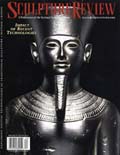
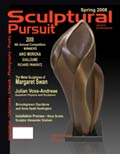
Recent articles written by Ms. Mongeon
“Exploring Digital Technologies as Applied to Traditional Sculpting.” Sculpture Review. (Winter 2007) 30.
“The American.” Sculpture Review. (Winter 2007) 32.“Artful Business-The Basics of Designing your Website.” Sculptural Pursuit. Vol. 7 No. 1. (Spring 2008) 50. March 2004
All written work is copyrighted and cannot be used, whole or in part,
without the written consent of the author.
You Could Lose Your Rights To All The Work You Have Ever Created
Created for Best of Artists and Artisans web site
By Bridgette Mongeon © 2008

Immediate action is needed concerning the
Senate Bill S. 2913 and House Bill H.R. 5889, the Orphan Works Acts of 2008.
America is known for the country that protects an individual’s rights. It is impossible for me to comprehend that my rights as an artist may soon drastically change, and that I could lose the rights to all the work that I have ever created. When I first heard about this, it was so unbelievable that I thought that it must be a prank. But, with further investigation I found it was not. In this article I will include a little about what I found and links with other articles for readers to peruse so that they can make their own informed decision. I am also setting up interviews with several people including Copyright lawyers, those in the writers unions, and even those in the American Federation of Television and Radio artists, to name a few. There is urgency in acting and spreading this information. For whatever reason, this is moving through congress quite quickly and will affect your rights and possibly your income as a creative person.
As I find more information and create these interviews, I will pass them on to the Editors at Best of Artists and Artisans sculpture blog to be posted at their discretion. I will also post all of the information that I find on my home page blog, located at https://creativesculpture.com/blog
COPYRIGHT LAW AS IT STANDS TODAY
First, a few basics about copyright law as it stands today. According to the copyright law of 1976, everything that you create is protected by copyright from the moment you create it, even if it is not registered. This is the way copyright is handled throughout the world. It was defined by the Berne convention, which is an international agreement concerning copyrights.
With the current Copyright law, you do need to register your work if you want to collect for statutory damages for infringement. If, however, your work is registered and you discover someone has stolen it and you file suit, statutory damages are punitive and can be quite severe for those infringing on someone’s rights. This very idea keeps many people honest about “taking” other people’s artwork.
“It is not what it appears to be, it is a Trojan horse… Under this orphan works legislation, nothing you do would be protected unless it is registered with these commercial registries… they are orphaning all unregistered work” Brad Holland
THE CHANGE IN LAWA radically proposed change to the US copyright law allows infringers to exploit the right of copyright holders with little or no penalty according to the Orphan Works Opposition Headquarters (OWOH). “Two bills currently on the “rocket docket” would let infringers “orphan” any copyrighted work whose owner the infringer failed to locate through a vaguely defined “reasonably diligent” search. The creative arts industry, including world-renowned artists, designers, photographers, manufacturers, and licensing businesses have united to oppose this legislation.”
The New Orphans Work Act declares that nothing you do would be protected unless you register it with a registry, placing a burden of diligence on the copyright owner. It must also be stated that even though these bills are moving quite fast through congress, registries do not, at this time, exist. These would be private registries where an artist would be responsible to register their art. In other words, every artist will have to pay to own their own work and each of their pieces will have to be registered, right down to the sketches in their sketchbook. If they are not and someone comes across your work and they search these directories and do not find it, then they can say that they performed a “reasonably diligent search.” They can use your work at no cost. As I comprehend the ramifications of this, the works that are presently copyrighted would also have to be reregistered. The cost of registering each piece of artwork, nevertheless the time that it would take to register each piece of artwork throughout an artists lifetime, makes this task impossible and prohibitively expensive.
It is interesting to note the following—It is a violation of the Berne Convention for the Protection of Literary and Artistic Works for any country to impose registration on a rights holder as a condition of protecting his copyright. See Article 5(2) “The enjoyment and the exercise of these rights shall not be subject to any formality (emphasis added).”, (From How the Orphan Works Bills Affect Visual Artists. Illustrators Partnership of American)
According to some of the interviews that I have listened to a creative person would also have to police their artwork, making sure that no one has taken it or it may be considered orphaned.” It is also said that you would have to reply to all inquiries on your artwork or it might be considered orphaned. All of this hardly leaves room for an artist to create.
OWOH states, “The new bills would severely “limit” financial penalties for infringing. Opponents charge this will encourage deliberate theft because statutory damages are the only tool the law gives copyright holders to prevent abuse– and they say it works. Penalties for infringement almost certainly deter rampant abuse by making it risky. But as medical illustrator Cynthia Turner notes ‘the new bills would protect infringers by denying artists damages, incurred court costs, attorneys’ fees and other expenses.'”
“Because these bills were planned behind closed doors, introduced with little warning and fast-tracked for imminent passage, a broad-based coalition of artists and trade associations say they have had little time to respond and generate public discussion. They say that a radical change in intellectual property law should not be rushed through Congress without public vetting. They are calling on Congress to slow down this legislation until it can be subjected to an open, informed and transparent public debate.”
Those in support of this bill are libraries and educators that claim that this bill is intended to give libraries and museums greater latitude to commercialize archived works. But, according to tp the OWOH, “critics charge the bills have been drafted so broadly they would permit any infringer to commercially exploit any copyrighted work, from professional art to family photos.” Those supporting the bill say that if artwork is worth something it should be registered. But if it is not worth something why would others want to take it?
Brad Holland of the Illustrators Partnership of America comments on the bill, ‘It is not what it appears to be, it is a Trojan horse… Under this orphan works legislation, nothing you do would be protected unless it is registered with these commercial registries… they are orphaning all unregistered work”
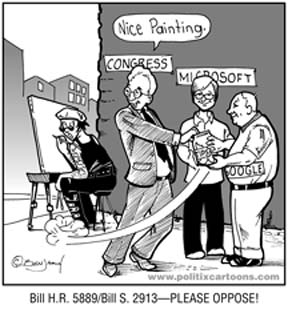
I encourage you to become familiar with the bill and take action accordingly. Your rights may be fading away without you even knowing it. If you would like to have your voice heard, The Illustrators Partnership of America has made it quite easy to take action. You can go to the web site and send an email, but faxes and letters are also encouraged. Please keep coming back for further information on this subject and send a link to this blog to other creative people that you know.
OTHER RESOURCES
Don’t take my word for it. You must decide how important this is to you. Here are some places to start.
- A wonderful resource of articles about this bill put out by the Illustrators’ Partnership
For comprehensive bill descriptions that describe the impact on visual artists:
House Bill http://capwiz.com/illustratorspartnership/issues/bills/?billid=11320236
Senate Bill http://capwiz.com/illustratorspartnership/issues/bills/?billid=11322171 - Video interview with brad Holland of the Illustrator’s Partnership
- American for the Arts on the Orphan words Legislation
- American Society of Media Photographs Update on 2008 Orphan Works Legislation
- Lawrence Lessig’s Op-Ed piece, in today’s New York Times
- Art Calendar article on the Orphan Works Act that also talks about Microsoft’s and Googles involvement.
- Public Knowledge concerning the Orphans work act
- Orphan Works Opposition Headquarters
- Plagiarism Today has several articles about the subject
- Attorney Tammy L Browning- Smith discusses the orphans works and Washington DC in her online blog Arts and crafts law
- Photography Director Rob Hagart discusses H.R.5889 ORPHAN WORKS ACT OF 2008 (INTRODUCED IN HOUSE) on his online blog
- An article from The Artist Foundation about the Orphan works Act
- The American Society of Media photographers throws in the towel and gets behind the bill, Johnathan Bailey describes why in this article ASMP Supports Orphan Works Bill. This site also has a video
- Mind Your Business: Don’t Lose the Rights to Your Artistic Creations, Animation World Magazine’s Mark Simon reports on alarming new developments in his continuing campaign against the Orphan Works Act.
- Why the Orphan Works Act is Uncles Sam’s Thieves’ Charter written by the Editorial photographers United Kingdom and Ireland
- A podcast with Alex Saviuk cartoonist of the spider man comics
